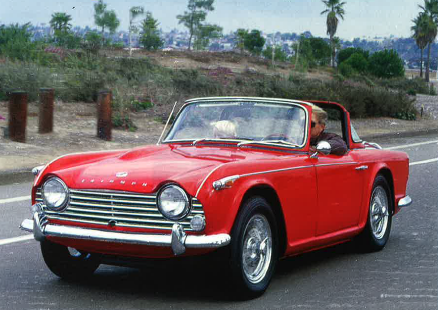By Alan Paradise
Triumph: just saying the name denotes a regal and victorious image. A car line that gained prominence in America by delivering small, nimble, intimate sports cars. A brand that over the past 50 years has gone from popular to abandoned, and, most recently, is quickly being elevated to cult-car status.
When first thought of, the most endearing images of Triumph sports cars are usually either a TR3 or TR6. Both these cars occupy very romantic positions in the Triumph storybook. However, when looking at the entire span of the Triumph line, it is easy to understand the role this automaker has had in the development of the sports car.
Shortly after World War II, two British automakers (Rolls Royce and Triumph) quickly reestablished themselves as balancing on the leading edge of automotive styling. In 1946, Triumph’s Sir John Black was determined to become the leader in sports car performance and styling. Black rapidly moved ahead with the 1800 Roadster, a car far in advance of anything from rivals MG and Jaguar. What Black and the rest of Triumph’s team did not know was that in 1949 Jaguar would introduce the XK120, making even the upgraded 2000 Roadster (also released in 1949) a distant second place sports car. Overpowering the Triumph 2000 by 100 horsepower, the Jaguar XK120 set new levels of beauty and performance. Unable to run stride for stride with Jaguar, Triumph knew it could compete in price with the more closely matched MG.
Throughout the 1950s, Triumph would play a game of cat and mouse with MG. In 1953, the first TR series car was introduced. The TR2 was an instant success, especially in a growing American market. Sales of TR2 and TR3 models rolled along at a steady, although not blockbuster, pace from 1953-57. No longer in the same sports car category as Jaguar, Triumph’s primary competition remained MG. The styling and image of the TR2 was more glamorous and modern than that of the MG TF. However, when MG produced and imported the MGA, the game changed, and so did Triumph’s fortunes. The MGA took the flowing lines of the TR2 and TR3 a few steps further. Desire for the TRs dropped as sales of MGAs increased—this despite the overall performance advantage of the TR3 (100 horsepower versus the MGA’s maximum of 93).
In 1958, Triumph performed a mild styling upgrade with the TR3A. The wide-mouth grille, exterior door handles, and more civilized seating were just part of the improvements. Handling was superior to the TR3, putting it on par with the MGA.
By 1960, the game with MG was becoming a war. This was a time when Porsche was making great strides with its 356 and American automakers were on a complete power trip. Giving up any market share for perky, intimate sports cars was something neither Triumph nor MG could afford.
In 1961, the TR4 was released. This was the first of the new generation English sports cars. The Italian-designed body was secured to a TR3A chassis and running gear. Besides the sophisticated styling, the new TR4 continued to advance its engineering by offering fully independent rear suspension in 1965. The TR4 raised the bar for affordable sports cars and quickly eclipsed the MGA as the sports car of choice within its class. Even with the introduction by MG of the MGB, the TR4 continued to clearly establish itself as a fine sportsman’s roadster. From 1961 through 1968, the TR4 enjoyed minor upgrades. These included the TR250 model and the very scarce TR5 (never officially sold in the U.S.).
For the 1969 model year, the TR6 would come to America. This was Triumph’s finest time. Over 94,000 TR6 models were produced from 1969 to 1976, a testimony to its popularity. The TR6 body was a stunning Karmann redesign of the TR4. This was now an English-powered sports car with Italian lines refined by German hands. This was quite a combination. The TR6 was in a class by itself as the MGC was discontinued. The nearest competitor came in 1973 with the importation of the Jensen-Healey. The two cars had similar target markets, but vastly different styling and specifications. The Jensen-Healey, like the TR6, disappeared from new car showrooms in early 1977.
As popular as the TR6 was, its sales paled to that of the MGB. Today the TR6 has become a desirable sports car. Enthusiasts are attracted to the reliability, torque, and power of the inline six-cylinder engine. The handsome bodylines are as engaging today as they were in 1969.
The final chapter in the Triumph story was the wedge-shaped TR7 and TR8 models. When the TR7 was brought to America, it was “the shape of things to come.” As Triumph collapsed and folded, the TR8 was the shape of things that went. As unique and maligned as the TR7 and TR8 were, they too played a significant role in the evolution of personal sports cars. The wedge-shaped body became a much-copied design. In addition, the TR7 enjoyed a very successful life in SCCA racing, winning many class championships in the 1970s.
During the life and times of Triumph, there have been many significant mile markers. Along with MG, they virtually created the American personal sports car market. Because of this, the Triumph and MG names will forever be linked. The two companies waged a “friendly” battle from 1946 to the ultimate demise of each in the early 1980s. Over the years, MG won the sales title, but Triumph has carved its own niche the hearts of enthusiasts.
In 2001, the entire Triumph line is experiencing a rebirth. Many automotive historians and enthusiasts are rediscovering the unique appeal of Triumph’s form and function attitude to sports cars design. Much like these cars were when new, the TR2, 3, 4, and 6 are very affordable pieces of motoring history. The book is still out on the TR7, 8, Spitfire, GT6, and Stag. Chances are, with the special features and innovative ideas each offered, these too will achieve a niche following.
What will continue to keep the Triumph name and spirit alive are the outward timeless beauty and the inward engineering. With a loyal group of dedicated enthusiasts and the continued availability of restoration parts and services, much of the Triumph sports car line will be with us for many decades to come.












'Triumph in America' has no comments
Be the first to comment this post!